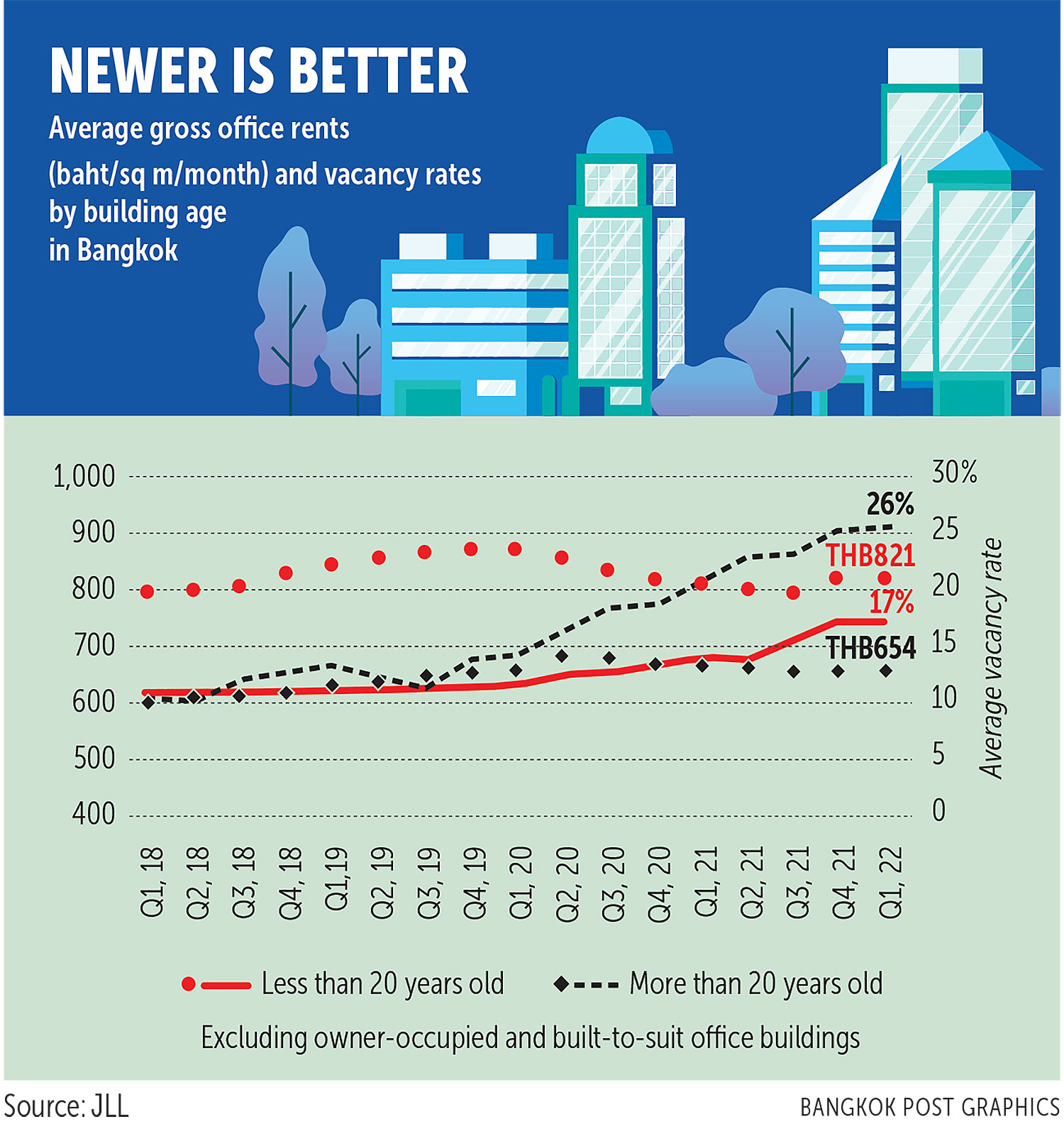Thailand: Ageing office buildings under pressure
Amid growing competition in the Bangkok office market, fuelled by a large amount of new supply in the pipeline, ageing office buildings are losing their ability to retain and attract occupiers.
This trend is putting pressure on landlords of older buildings to become more proactive and find ways to enhance the value and competitiveness of their assets, according to the property consultancy JLL.
“JLL’s leasing activity data shows that the majority of new leases are being signed within modern office buildings, showing a clear preference among occupiers,” said Jeremy O’Sullivan, head of research and consulting at JLL. “Consequently, buildings that were built before 2002, which are referred to as ‘ageing’, are typically struggling to attract new occupiers.
“Compared to the top-grade new supply coming to market, ageing buildings generally have inferior design, facilities and technology. Some were previously prime grade buildings that have been downgraded to the secondary tier in recent years.”
The latest study by JLL shows the total stock of office space in Bangkok at 9.97 million square metres, of which nearly 70% represents buildings aged over 20 years. In buildings aged 20 years or less, the average vacancy rate was 17% and the average rental was 821 baht per sq m per month at the end of the first quarter of 2022. For older buildings, the average vacancy rate was 26% and the average monthly rental was 654 baht per sq m.
Between now and 2026, the Bangkok office market will see an additional 2.2 million sq m of new space. Of this, more than 1.7 million sq m or 81% will consist of prime grade developments. JLL expects this to raise vacancies and put further downward pressure on rents in ageing, secondary grade buildings.
“The growing availability of new prime office supply means that occupiers now have more options when it comes to site selection for their workplace,” said Thananun Ruengveeravich, head of office leasing advisory at JLL. “We have seen an increasing number of occupiers taking this opportunity to review their office efficiency and consider relocation to newer buildings.”
Findings from the JLL study show that between the second quarter of 2021 and the first quarter of 2022, the Bangkok office market saw negative net absorption of 82,000 sq m. However, buildings on which construction was completed in 2011 or later continued to see positive net absorption of 99,000 sq m, versus 181,000 sq m of negative take-up in older buildings.
“In response to the flight-to-quality trend of occupiers, some landlords of older, secondary-grade buildings are considering offering rental discounts to maintain or boost occupancy, while more proactive landlords are looking for a strategy to enhance their ageing assets to stay relevant and meet evolving demand from occupiers in the long term,” said Mr Thananun.
Natcha Taepongsorat, head of asset enhancement at JLL, said that other than pricing strategy, landlords of ageing buildings can consider asset enhancement as a longer-term solution to improve performance, reduce operating costs, increase revenue and avoid obsolescence. “This includes a wide range of strategies from operational efficiency improvement, property management and sustainability enhancement through to revitalisation,” she said.
JLL’s observations show that revitalisation has gained popularity among well-located secondary-grade office buildings whose landlords are looking to improve cash flow and net operating incomes of their assets. Investment costs typically range from 30 million to 200 million baht, depending on each asset and the scale of renovation.
Some landlords may also get their ageing office buildings renovated to become more sustainable or meet green standards such as LEED (Leadership in Energy and Environmental Design) or TREES (Thai Rating of Energy and Environmental Sustainability) in order to attract a growing number of corporations with a net-zero target, while reducing utility bills in the long run.
“The optimal building upgrade helps future-proof assets and allows them to remain competitive in the challenging market, which is reflected in rental improvement and a reduction in operating costs,” said Ms Natcha.
“With higher income and building quality, enhanced projects are generally appraised with higher values, benefiting landlords and forthcoming investors.
Asset enhancement strategies and scales vary, she added. “It is critical for landlords and investors to evaluate their asset performance, expectations of their target occupiers and their own expectations for return on investment before making any asset enhancement decision. This will help ensure the most impactful and cost-effective option and prevent over-investment.”
Source: https://www.bangkokpost.com/business/2364411/ageing-office-buildings-under-pressure


 Thailand
Thailand




